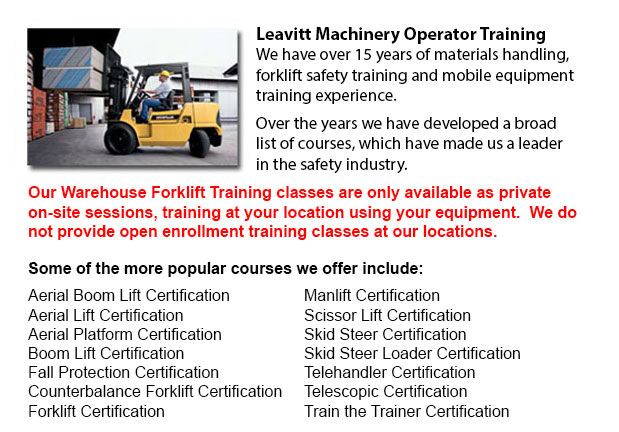
Warehouse Forklift Training Programs Vernon - Warehouses can either be retail, industrial or commercial facilities, functioning from product distribution services to bulk product retailing. Regardless of the kind of warehouse, staff within warehouse settings must be well trained in safety measures related to material handling and storage, loading docks, conveyor systems, and pallet jacks and forklifts. Good housekeeping is vital to a safe and orderly warehouse setting.
The loading dock system is often build into the warehouse at a height from the ground making it easy to move stuff moving out and coming in of the warehouse. Personnel would likewise load and unload materials and merchandise from the ramps and elevated docks. Particular attention must be paid to safety practice during this stage. In order to avoid falls, install yellow striping along the edge of docks and ramps. Pay attention to the area all-around delivery trucks that are parked at the loading dock, especially the area between truck and dock. Be certain that when unloading, truck wheels are chocked.
To distribute products in the facility, some warehouses make use of a conveyor system. These systems are designed with moving belts and wheels which can pose a pinch point danger. Keep parts of the body and hair well away from conveyors to avoid injury. Elevated conveyors pose a hazard to personnel beneath if safety nets are absent. Employees should know how to stop conveyors in the event of emergency. Be aware of the location of emergency stop buttons and off switches. When servicing conveyors, lock out/tag out procedures are mandatory.
Forklifts and pallet jacks are designed to move materials all-around the warehouse. Forklift operators are required to take training and receive certification. Operators of pallet jacks do not need certification, but should be trained on the equipment. Training courses instruct operators in the proper ways for hoisting materials and moving them to their assigned location. Neither forklifts nor pallet jacks should ever be utilized to transport or lift workers.
To allow for adequate room for machinery and people to pass, storage shelving and rack systems help to create an orderly and efficient work area, specially if they are correctly braced. Slow and careful placement of good is needed to prevent accidents caused by products falling off the facing aisle. Aisles should be kept clear by keeping products flat and in the shelving units. Pallets are used for stacking products. They should be in good condition, and palleted products should be baled or shrink-wrapped, whenever possible.
PPE or personal protective equipment should be worn when needed to help protect the employees' limbs, heads, feet and hands. Hard hats or bump caps, gloves and steel-toed shoes are common PPE.
Slippery floors which are pocked with dents and pits can present significant dangers, making good housekeeping very vital. Warehouse docks and floors should be clear of dirt, debris and oil. The area must be kept clear of trash, boxes and baling supplies.
-
Heavy Equipment Training Vernon
Heavy Equipment Training Vernon - The two most common kinds of heavy equipment training are categorized into the categories of equipment; equipment which is fashioned with tracks and those with rubber tires. The tracked vehicle are heavy duty machine... More -
Aerial Lift, Boom Lift, Man Lift, Scissor Lift Training in Vernon
Lift tables or scissor platform lifts could lift up both people and materials vertically. They are most often utilized in industrial, construction and commercial environments. Usually, the use of a scissor lift is to lift and lower materials from one... More -
Crane Operator Classes Vernon
Crane Operator Classes Vernon - Crane operator training is for operators and supervisors of overhead lifting equipment. The course is suitable for both current and new operators. Course content addresses relevant provincial, state and federal safety... More -
Zoom Boom Training Vernon
Zoom Boom Training Vernon - Zoom Boom Training focuses on correctly training potential operators on variable reach forklifts. The training objectives consist of gaining the knowledge of the machine's physics and to be able to define the tasks of the... More -
Skid Steer Ticket Vernon
Skid Steer Ticket Vernon - The lift arms on the skid-steer loader are situated alongside the driver together with pivots at the back of the driver's shoulders. These features makes the skid-steer loader different than the traditional front loader. Be... More -
Manlift Ticket Vernon
Manlift Ticket Vernon - The Elevated Platforms and Manlifts Certification course helps to provide the needed training on the safe operating procedures, work practice, rules and regulations regarding the daily activities for the operators of this mach... More -
Scissor Lift Ticket Vernon
Scissor Lift Ticket Vernon - The scissor forklift has been a great advantage to many businesses in view of the fact that the effort and manpower to run one of these machines is very minimum. Furthermore, numerous workplace injuries have been prevente... More -
Aerial Lift Safety Training Vernon
Aerial Lift Safety Training Vernon - There are roughly 26 to 30 construction fatalities in North America due to the utilization of aerial lifts. Nearly all of the individuals killed are craftsmen like for example painters, electrical workers, laborer... More

Forklift Training Vernon
TOLL FREE: 1-888-254-6157
Vernon, British Columbia
forklifttrainingvernon.com
Email Us
About Us


